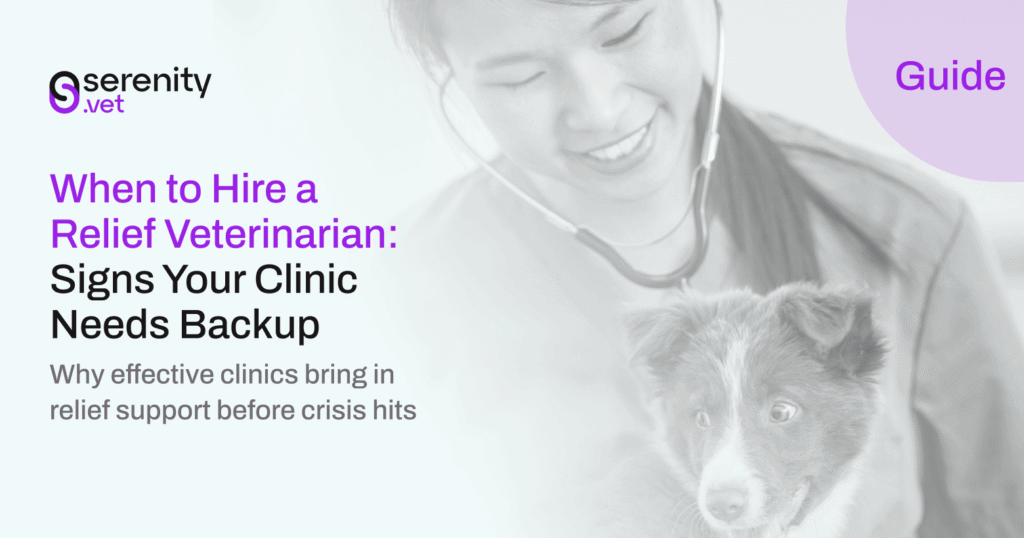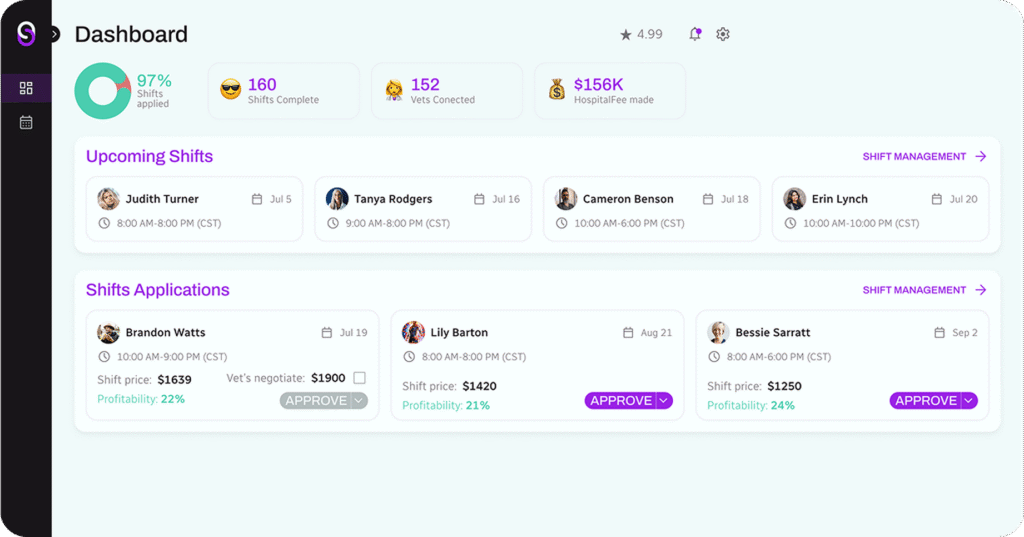
When to Hire a Relief Veterinarian: Signs Your Clinic Needs Backup
Your clinic is busy. The phones keep ringing, exam rooms stay full, and your team moves fast to keep pace. On most days, it feels manageable… until something shifts. Flu season hits. Summer travel brings a surge of vaccine appointments. Suddenly the balance tips, and the schedule that once felt under control is one case away from breaking.
It’s a familiar story. Most practices are busier than ever, but busyness isn’t the same as sustainability. A schedule that never lets up doesn’t just stretch capacity, it wears people down. In fact, more than 85% of veterinarians report moderate to high levels of burnout, costing clinics an estimated $1–2 billion annually in turnover, lost productivity, and recruitment expenses.
Those numbers aren’t abstract. They show what happens when clinics run chronically understaffed. Without backup, the pressure lands squarely on your core team, pushing them toward exhaustion and driving up the very costs managers try to avoid. A relief veterinarian isn’t just filling a shift; they’re absorbing the pressure before it fractures your team and your bottom line.
Too often, relief vets are treated as a last resort. But the smartest clinics don’t wait until they’re in crisis. They recognize the warning signs early and act before the stress snowballs.
In this article, we’ll walk through the five signs your clinic may need backup, and why hiring relief proactively is one of the most strategic moves a practice can make.
Sign 1: Rising Wait Times and Overflowing Schedules

Most clinics consider full appointment books a good problem to have. But when “fully booked” turns into clients waiting two-three weeks for a wellness exam, or being turned away for same-day care, the signal is clear: you’re running past capacity.
Long waits frustrate pet owners and chip away at their trust in your practice. A client who can’t get in for a vaccine booster or urgent skin issue may start calling other hospitals. In competitive markets, that lost call often turns into a lost client.
Overflowing schedules also push your team into survival mode. Doctors rush through cases to stay on time, technicians get pulled in three directions at once, and follow-up opportunities (dentals, diagnostics, preventive care) slip through the cracks. What looks like “being busy” can actually mean leaving revenue (and care quality) on the table.
Relief veterinarians act as a release valve. By taking on part of the caseload, they free up your core team to spend more time with each patient, catch important medical details, and keep the schedule flowing at a humane pace. In practice, that can mean the difference between a team barely holding it together and one that ends the day knowing they gave clients their best.
Sign 2: Team Burnout & Turnover Warnings
Burnout in veterinary medicine rarely shows up overnight. It builds slowly—fatigue that shows up in morning rounds, an uptick in sick days, and slipping quality in client communication. These are warning lights. But what turns warnings into full-blown problems is turnover, and that’s where the costs really hit.
Maybe it starts with one technician deciding they’ve had enough. Then another follows. Or it’s a doctor who’s been with your clinic for years finally walking away. Suddenly, the “savings” from avoiding relief coverage disappear, replaced by recruiting bills, extra strain on the remaining team, and clients who feel the ripple effect in longer waits and thinner service.
According to the 2024 AAHA Stay, Please survey, veterinary clinics are seeing an average turnover rate of 23% among their team members. And when someone leaves, it’s never as simple as posting a job ad. By the time you’ve recruited, trained, and covered the gaps in care, you’ve spent 1.5 to 2 times that person’s salary.
Relief veterinarians help keep you from reaching that point. By taking some of the load, they give your core team space to breathe, making it far more likely your staff stay, your culture holds, and those avoidable costs never hit your books.
Find Relief Vets on Your Terms
Set the rate, pick the vet, and keep your clinic running at full speed.
Sign 3: Seasonal Surges and Unpredictable Caseloads

Even the best-planned schedule can be upended by waves of demand. Summer travel brings vaccine updates and boarding visits. A sudden heatwave sends in patients with heatstroke. Flu season creates a spike in urgent-care cases. And sometimes it’s simply unpredictable: a cluster of emergencies in one week, or a surge in new clients after a nearby clinic reduces hours.
In moments like these, teams often go into overdrive: squeezing in extra appointments, shortening visit times, and asking staff to stretch just a little further. It works in the short term, but the trade-offs are real. Rushed exams mean details get missed. Staff finish their shifts drained, with nothing left in the tank for the next day. Clients who waited weeks for an appointment feel like they’ve been brushed through.
Relief veterinarians give you a way to absorb those peaks without burning out your core team. Whether they’re covering routine visits so your doctors can focus on urgent cases, or stepping in to handle overflow during the busiest weeks, they help the clinic maintain consistency. The real value is stability. Seasonal spikes and sudden surges don’t have to derail your clinic’s rhythm. With relief coverage in place, the calendar stays manageable, your team stays steady, and clients still get timely care, even when demand is anything but predictable.
Sign 4: Doctors Needing Time Off
Time off in veterinary medicine shouldn’t be a guilty luxury. Vacations, parental leave, and continuing education are part of a healthy career, not interruptions to be resented. Yet too many clinics run so lean that when a doctor steps away, the rest of the team feels the strain instantly.
The result? Doctors postpone vacations year after year. CE gets rushed. Sick leave is cut short. It may look like dedication, but it’s often quiet exhaustion building up under the surface. And in the long run, it’s unsustainable.
Relief vets give your team permission to step away without worrying about what they’ll return to. The clinic keeps running smoothly, clients continue to feel cared for, and colleagues aren’t left stretched beyond their limits. Over time, that kind of support sends a clear message: this is a workplace that values balance, which makes it easier to keep good people for the long run.
Sign 5: Loss of Growth Opportunities

Most practices have a list of things they’d love to do somedays. Add dentistry days. Launch urgent care hours. Expand into telemedicine. Train technicians to take on more advanced roles.
But if the team is already running at full tilt, growth initiatives are the first to be shelved. The urgent always crowds out the important. Months (or years!) pass without those ideas moving forward, not because they weren’t valuable, but because there was never enough bandwidth to make them real.
Having Relief support changes that equation. When the daily schedule isn’t consuming every ounce of energy, doctors and managers finally have room to focus on the future, whether that means new services, staff development, or community outreach. Instead of just fighting fires, the clinic can invest in the kind of growth that builds long-term resilience.
The Common Thread: Profitability at Risk
Every sign we’ve covered — overflowing schedules, staff burnout, seasonal surges, deferred time off, and stalled growth — points back to the same theme: profitability quietly erodes when a clinic runs at or beyond its limits.
The costs don’t always show up immediately on a balance sheet, but they’re real:
- Turnover: Replacing a departing veterinary professional can cost 1.5-2× their annual salary once recruiting, onboarding, and lost productivity are factored in (AAHA Stay, Please survey, 2024).
- Lost appointments: AVMA data shows many pet owners now wait a week or more for nonemergency visits. Each client who can’t get scheduled is not just a missed appointment but potentially a lost client to another hospital.
- Stalled services: When teams are maxed out, new initiatives — like dentistry days, urgent care hours, or technician training — get pushed aside. Each delay is untapped revenue and lost competitive advantage.
Add it up, and the “savings” from avoiding relief coverage are dwarfed by the hidden costs of running short-staffed. Relief veterinarians help flip the equation. By keeping capacity open, protecting staff from burnout, and giving the team breathing room to grow, they protect both patient care and the clinic’s financial health.
How Serenity Vet Simplifies Relief Staffing

Even when you know it’s time to bring in relief support, the process itself can feel like another full-time job. Posting shifts, reviewing applications, comparing rates, and juggling back-and-forth emails all take time your team doesn’t have. That’s exactly the bottleneck Serenity Vet was built to solve.
Instead of leaving practices to chance, Serenity Vet gives you the tools and data to make smarter, more confident decisions:
- Set Your Own Rate
You decide what to pay, then use rate guidance and local benchmarks to make sure it’s competitive and sustainable. - Profitability Calculator
See how different pay rates affect your bottom line before you post the shift. Relief staffing becomes a strategic choice, not a financial risk. - Production Bonuses
Want to reward high performance? Build in production-based incentives that motivate top vets to pick your shift. - Negotiation & Transparency Tools
No back-and-forth emails or vague fee structures. You see exactly how much a vet will be paid, and you have clear ranges for accepting or declining proposals. - Targeted Notifications & Predictability
Your shift gets in front of qualified vets immediately. In the U.S., our AI Predictability Tool even shows you how likely the shift is to be filled, and what adjustments would improve your odds. - Pay-as-You-Go Simplicity
You only pay for completed shifts. No long-term commitments, no sunk costs.
Create your account to start posting shifts, reviewing profiles, and connecting with relief vets who are ready to step in and help your clinic thrive.

